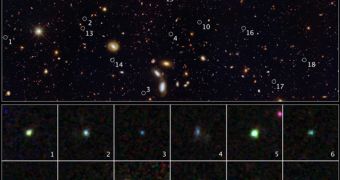Astronomers operating the Hubble Space Telescope announce the discovery of a large number of dwarf galaxies in the observatory's deep field. The observation sessions that managed to reveal these cosmic structures focused on an area located about 9 billion light-years away.
What this implies is that Hubble saw these young dwarf galaxies as they appeared just 4.75 billion years after the Big Bang “exploded” the Universe into being. The most remarkable thing about this galactic population is that its members appear to be producing stars at a frantic pace.
Experts say that instances in which such rapid stellar formation was observed in dwarf galaxies are exceedingly rare. In other words, it could be that experts will have to find new ways of explaining the formation of galaxies, regardless of their size and bulk.
All formations the telescope discovered are very small when compared to the Milky Way, even if our own galaxy began developing at around the same time. Our home has a diameter of about 120,000 light-years, and is itself orbited by several dwarf galaxies, Space reports.
However, unlike the Milky Way, dwarf galaxies in this group produce stars so fast that experts expect a doubling of their individual stellar populations within about 10 million years. In astronomical scales, this is extremely fast, researchers say.
Hubble conducted its new observations in near-infrared wavelengths, because the young stars in these dwarf galaxies produce a lot of radiation. These radiations then go on to heat up oxygen inside cosmic gas, making it glow in near-IR frequencies.
The research team that conducted the investigation is based at the Max Planck Institute for Astronomy, in Heidelberg, Germany, and is led by astronomer Arjen van der Wel. He is also the lead author of a paper describing the study, which will appear in the November 14 issue of the Astrophysical Journal.
“The galaxies have been there all along, but up until recently astronomers have been able only to survey tiny patches of sky at the sensitivities necessary to detect them. We weren't looking specifically for these galaxies, but they stood out because of their unusual colors,” van der Wel explains.
He adds that the study was carried out as part of the three-year Cosmic Assembly Near-infrared Deep Extragalactic Legacy Survey (CANDELS). This research initiative is meant to analyze as many of the youngest visible galaxies as possible, in order for researchers to better understand the early Universe.
“In addition to the images, Hubble has captured spectra that show us the oxygen in a handful of galaxies and confirmed their extreme star-forming nature,” NASA Goddard Space Flight Center (GSFC) astronomer and study coauthor Amber Straughn says.
“Spectra are like fingerprints. They tell us the galaxies' chemical composition,” the investigator concludes.

 14 DAY TRIAL //
14 DAY TRIAL //